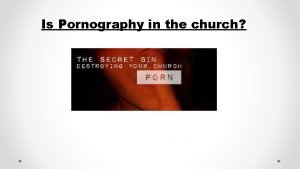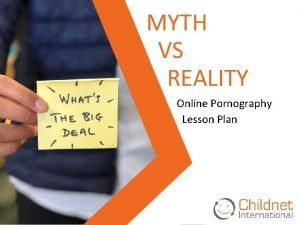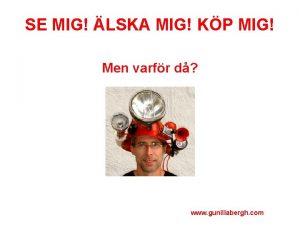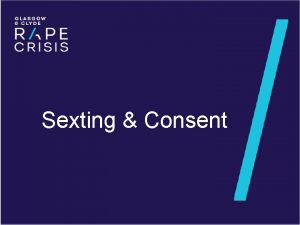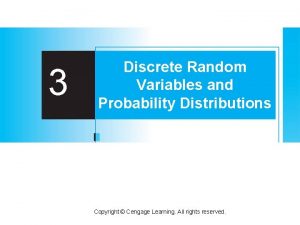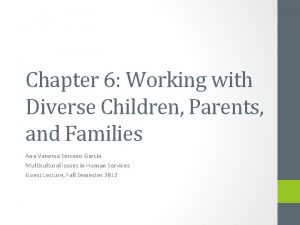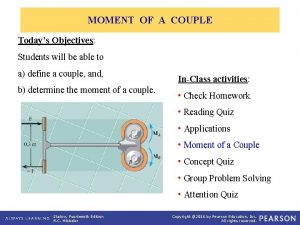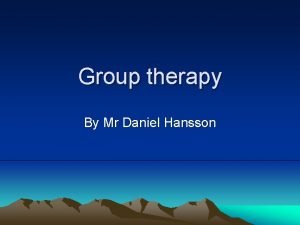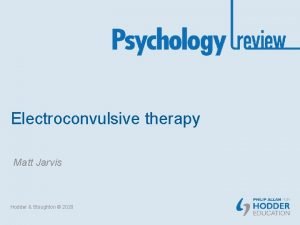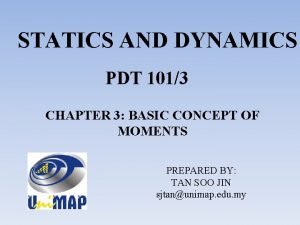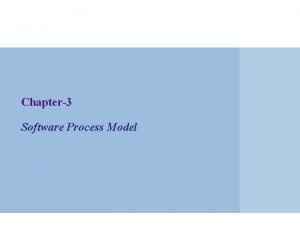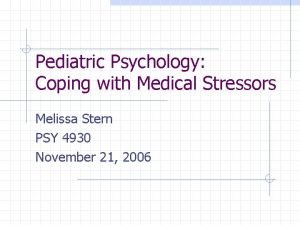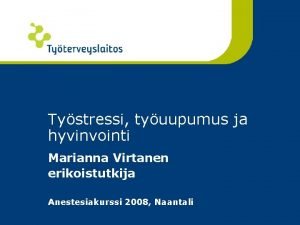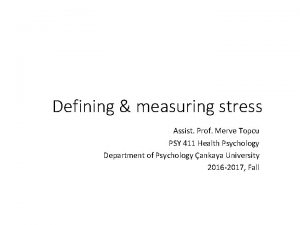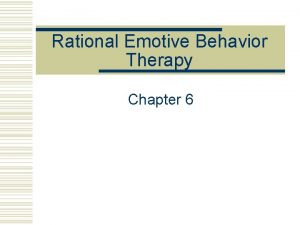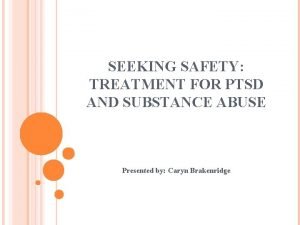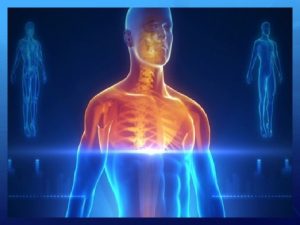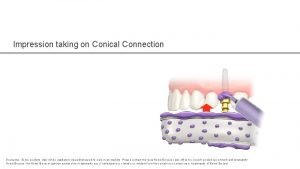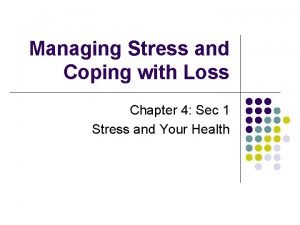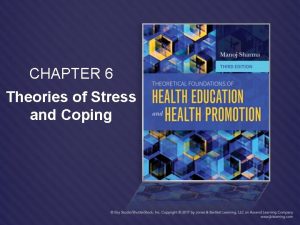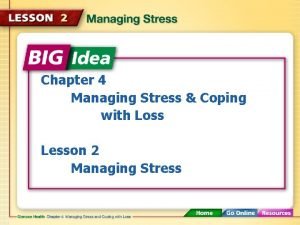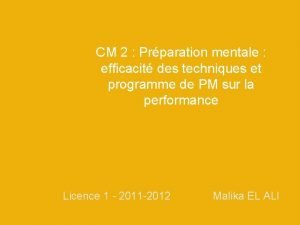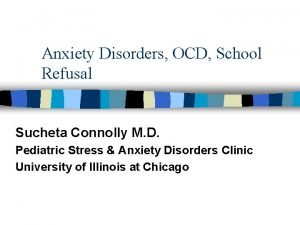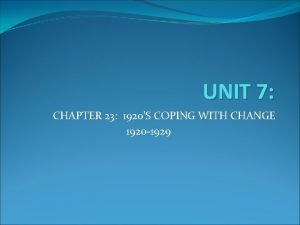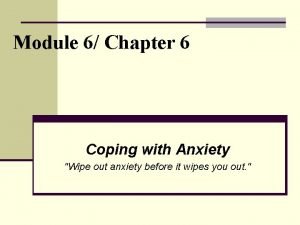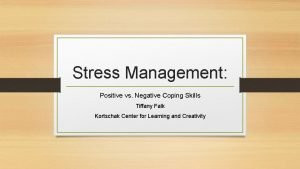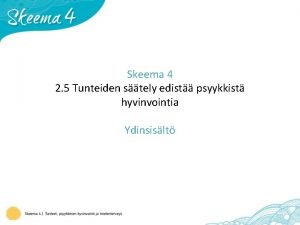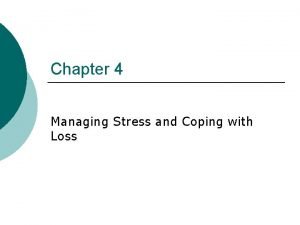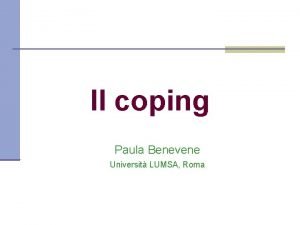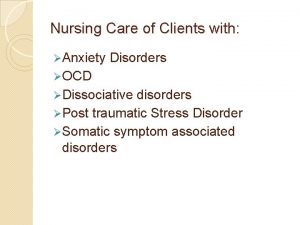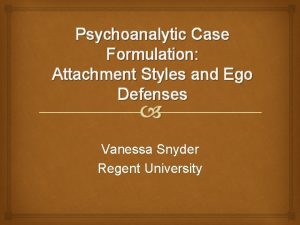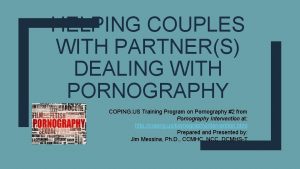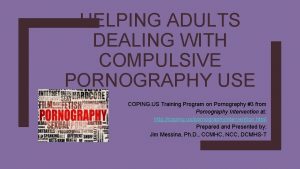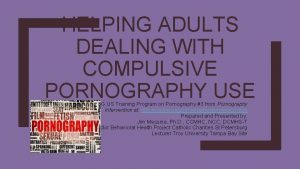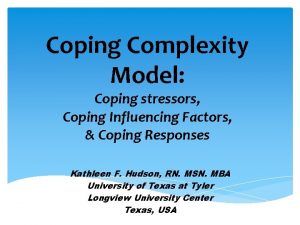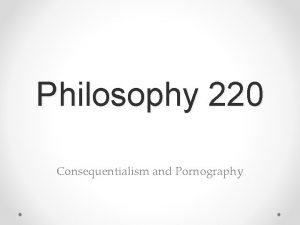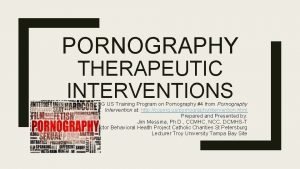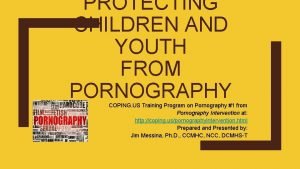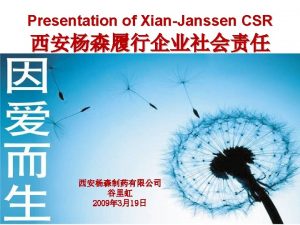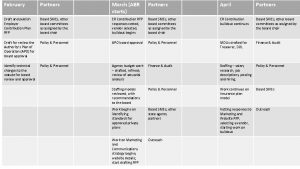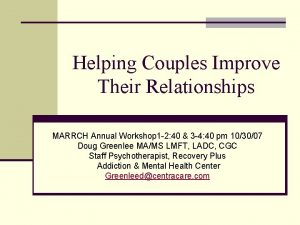HELPING COUPLES WITH PARTNERS DEALING WITH PORNOGRAPHY COPING






























































- Slides: 62

HELPING COUPLES WITH PARTNER(S) DEALING WITH PORNOGRAPHY COPING. US Training Program on Pornography #2 from Pornography Intervention at: http: //coping. us/pornographyintervention. html Prepared and Presented by: Jim Messina, Ph. D. , CCMHC, NCC, DCMHS-T Director Behavioral Health Project Catholic Charities St Petersburg Lecturer Troy University Tampa Bay Site

Pornography Intervention for Couples (2 nd of 4 Programs on Pornography Intervention) Description of Program: This program takes an intervention orientation to an emerging epidemic of internet pornography that threatens marriages and family life of compulsive pornography users. There is a need to train mental health professionals on how to assist couples who are dealing with the grips of compulsive pornography use in their relationships. Also, therapists need to learn how to conduct community wide education programming to awaken married couples to this crisis and to help them develop strategies to deal with it in their marriages. Helping couples grapple with this new challenge to their marital happiness can result in renewed marital commitment and conviction to fight this issue in a joint way. Therapists need help on what to say, how to say it and how not to use shame, guilting and outing to get the couples to come to grips with this issue in their lives Leaning Objectives 1. To learn about the impact of pornography on marriage in America today with an exploration of what types of pornography are out there and on what platforms they are present. 2. To learn about the neuroscience of watching pornography which leads to the compulsive need for more pornography to satisfy the mesolimbic reward centers of the brain. 3. To learn techniques which couples can use to collaboratively work to lessen the impact of compulsive pornography in their lives and to learn how to grow stronger as couples committed to a strengthened marital bond to enable them to face any future challenges that come its ways. 4. To learn about the resources to supplement the treatment of couples coping with compulsive pornography use, which can be incorporated into all types of institutions in the community, churches, civic organizations and social media.

IMPACT OF PORNOGRAPHY ON COUPLES & MARRIAGES

Why Now? ■ In 2006 with the introduction of High Speed Internet systems the world has been turned upside down when it come to Pornography and the ease of its accessibility ■ No one dreamed of this problem which is now at epidemic proportions ■ In 2010 the Professional Literature began to be crowded with research on the impact of internet pornography or cybersex ■ Today there is enough documentation to convince mental health professionals, pastoral leaders, school officials and governmental agencies that there is a whole new study out there about the prevention of compulsive pornography use by children, teens, young adults, and married partners ■ The time has come to deal with this issue seriously and for this reason Coping. US Training Programs has 4 distinct programs on Pornography Intervention ■ They are: – Pornography Prevention Program Strategies for parents with children and teens – Pornography Intervention for Couples – Pornography Intervention for Adults – Pornography Therapeutic Interventions for Mental Health Professionals

Impact of Pornography on Marriages in ■ A 2016 study identified that men’s sexual difficulties and the sharp rise in erectile America dysfunction, delayed ejaculation, decreased sexual satisfaction, and diminished libido during partnered sex in men under 40 is directly related to overuse of internet pornography. The study concluded that alterations to the brain's motivational system are the etiology underlying pornography-related sexual dysfunctions (Park et al. , 2016). Their explanation is that the characteristics of internet pornography may be potent enough to condition sexual arousal that do not readily transition to real life partners. These characteristics include: ■ Limitless novelty ■ Potential for easy escalation to more extreme material ■ Video formats ■ The result of the impact of internet pornography is that ■ sex with desired partners may not register as meeting expectation and arousal declines. ■ Clinical reports suggest: ■ Terminating internet pornography use is sometimes sufficient to reverse negative effects. (Park et al. , 2016).

Self-Perceived Pornography Addiction ■ By 2016, an estimated 40 million adults in the U. S. regularly view Internet pornography ■ 10 percent of whom admit to having an addiction to Internet pornography ■ Self-perceived pornography addiction (SPPA) has increasingly emerged as a concept in research & popular culture. ■ “Pornography or porn addiction” is not a formally recognized disorder & there is disagreement among researchers regarding its definition or even its existence however there are reliable findings about its impact ■ How Compulsive Pornography Use is operationalized often varies & this influences conclusions made about the impact of Compulsive Pornography Use ■ Compulsive Pornography Use is most frequently operationalized as excessive pornography use with negative consequences ■ Compulsive Pornography Use is reported to affect users & their partners in similar ways, such as increased feelings of isolation & relationship breakdowns ■ There still exist a debate regarding the definition & etiology of Self-Perceived Pornography Addiction as distinct from self-perceived sex addiction (Health & Medicine, 2016).

Psychological Distress Directly Related to Compulsive Pornography Use A 2015 study examined how the notion of perceived addiction to Internet pornography might be related to other domains of psychological functioning The study demonstrated that: ■ The notion of perceived addiction to Internet pornography is very robustly related to various measures of psychological distress ■ The relation between psychological distress & perceived addiction to Internet pornography persisted, even when other potential contributors (neuroticism, selfcontrol, amount of time, spent viewing pornography) were controlled for statistically (Grubbs, Volk, Exline & Pargament, 2015).

Impact of Compulsive Pornography Use on Marital Partners A survey of women in 2015, found that their reports of their male partners’ pornography use were related: ■ to less relationship satisfaction ■ more psychological distress. ■ In addition, relationship trust mediated the links between male partners’ perceived pornography use & relationship satisfaction & psychological distress Results from the moderation analyses indicated that: ■ the direct effect of male partners’ perceived pornography use & relationship trust & the conditional indirect effects of male partners’ perceived pornography use on both relationship satisfaction & psychological distress were contingent on relationship investment ■ These findings indicated that when male partners’ perceived pornography use is high, women who have low or mean levels of relationship investment have less relationship trust ■ The survey revealed that the relationship between male partners’ perceived pornography use & relational & psychological outcomes exist regardless of women’s own attitudes toward pornography (Szymanski, Feltman & Dunn, 2015).

Pornography Leads to FWB Which Impacts Relationship Commitments Friends with benefits (FWB) relationships integrate two types of relationship: 1. friendship & 2. relationship that includes sexual intimacy but without an expectation of commitment ■ These relationships are often seen as less risky than other casual sexual behaviors, but they still pose a high risk of contracting a Sexually Transmitted Infection (STI) ■ Pornography consumption has been connected to increases in risky sexual behavior in casual sex A 2015 study into pornography use influencing FWB behaviors, specifically through the mechanism of sexual scripts demonstrated that more frequent viewing of pornography is associated with: ■ A higher incidence of FWB relationships ■ A higher number of unique FWB partners ■ Engagement in all types of risky sexual behaviors during FWB relationships ■ More permissive sexual scripts mediated the association between frequency of pornography use & FWB behaviors

Impact of Pornography on Commitment to Relationships ■ A 2014 study investigated female participants in committed relationships concerning honesty regarding pornography use & mutual consumption between partners, along with honesty & mutual use as predictors of satisfaction ■ Participants reporting more honesty showed higher satisfaction & lower levels of distress ■ Participants disclosing mutual use showed lower levels of distress, although no differences were reported in satisfaction ■ Honesty regarding pornography use significantly predicted relationship dissatisfaction (Resch & Alderson, 2014).

Impact of Online Pornography on Sexist Attitudes of Males In 2014 a study investigated how the sexist attitudes of young adult males were affected when they were inadvertently exposed to online pornography & the role of the sense of anonymity in subsequent selection by these individuals of sexually explicit material Results of this study showed that: ■ Participants were more likely to pursue extreme pornography when they felt anonymous, as compared with situations in which they did not feel anonymous ■ This tendency was especially apparent for those exposed for 10 seconds to sexual online pop-up commercials that include pornographic content ■ The results also showed that inadvertent exposure to such sexual online pop-up commercials, coupled with feelings of anonymity, could increase participants’ sexist attitudes toward women (Shim & Paul, 2014).

Impact on Gender Role & Attachment Styles from Compulsive Male Porn Use A 2014 study examined, gender role conflict & attachment styles & consequences of poorer relationship quality & sexual satisfaction of men’s pornography use among adult heterosexual men - Findings revealed that: Both frequency of pornography use & problematic pornography use were related to: ■ greater gender role conflict ■ more avoidant & anxious attachment styles ■ poorer relationship quality ■ less sexual satisfaction ■ In addition, the findings provided support for a theorized mediated model in which gender role conflict was linked to relational outcomes both directly & indirectly via attachment styles & pornography use (Szymanski & Stewart-Richardson, 2014).

Pornography’s Use Impact on Relationships A 2013 study examined: ■ associations among pornography use ■ the meaning people attach to its use ■ sexual quality ■ relationship satisfaction ■ factors that discriminate between those who use pornography & those who do not Participants were couples who were either married or cohabiting at the time the data were gathered. Overall results from this study indicated substantial gender differences in terms of use profiles, as well as pornography’s association with relationship factors. Findings: ■ male pornography use was negatively associated with both male & female sexual quality ■ Female pornography use was positively associated with female sexual quality ■ Meaning explained a relatively small part of the relationship between pornography use & sexual quality (Poulsen, Busby & Galovan, 2013).

Impact on the Mental Health of Female Partners of Compulsive Porn Users A report in 2012 found that: ■ Women’s reports of their male partner’s frequency of pornography use were negatively associated with their relationship quality ■ More perceptions of problematic use of pornography were negatively correlated with the women’s self-esteem, relationship quality & sexual satisfaction ■ Due to the lowered self-esteem issues, women would continue in the relationship even with the perceptions of partner’s problematic pornography use & relationship quality ■ Relationship length moderated the relationship between perceptions of partner’s problematic pornography use & sexual satisfaction, with significant dissatisfaction being associated with longer relationship length (Stewart & Szymanski, 2012).

Pornography Use Weakens Commitment in Relationships A 2012 analysis of five different studies examined the correction between pornography consumption & commitment to romantic relationships with the expectation that higher levels of pornography consumption would correspond to weakened commitment in young adult romantic relationships. ■ Study 1: found that higher pornography consumption was related to lower commitment ■ Study 2: replicated this finding using observational data ■ Study 3: participants were randomly assigned to either refrain from viewing pornography or to a self-control task. those who continued using pornography reported lower levels of commitment than control participants ■ Study 4: participants consuming higher levels of pornography flirted more with an extradyadic partner during an online chat ■ Study 5: found that pornography consumption was positively related to infidelity & this association was mediated by commitment. ■ Overall: a consistent pattern of results was found using a variety of approaches with the conclusion that more pornography consumption is associated with a more weakened commitment to one’s relationship partner (Lambert, Negash, Stillman, Olmstead & Fincham,

Differences from Male & Female Use of Pornography In studying the differences between male and female use of pornography researchers found that males indicated: ■ a younger age of first exposure to pornography ■ higher total number of times pornography was viewed ■ more frequently viewing pornography within the last year compared to female participants ■ Although men viewed more pornography more frequently than women, both male & female participants reported similar reasons for viewing pornography ■ “Wanted the sexual excitement" was frequently indicated as a reason for viewing pornography ■ However, a higher percentage of women reported "never looking for pornography on purpose" than did men ■ The difference between "wanted the sexual excitement" and "never looking at pornography on purpose" was only 3%, suggesting that there is great discrepancy within reasons for viewing pornography among female participants. The discrepancy suggests that there is not a "typical" relation between women & pornography (Butler, Holm & Ferraro, 2011).

Wives of Sexual Addicts Give us a Hint to Wives Views of Pornography Addicts ■ A study of wives of sexual addicts in 2006 found that they experience distressing symptoms in response to the disclosure of their husbands’ compulsive sexual behaviors & often describe the disclosure event as traumatic ■ A majority of wives of sexual addicts respond to disclosure with significant trauma-related distress ■ The data also reveal that years married at the time of disclosure &number of previous traumatic event exposures best predicted total trauma symptom severity scores (Stefens & Rennie, 2006) In the survey the finding were: ■ 70% met most criteria for a diagnosis of post-traumatic stress disorder ■ 75% discovered evidence of compulsive or addictive sexual behaviors themselves (as opposed to a planned disclosure on the part of a husband) ■ 71% demonstrated a severe level of functional impairment in major areas of their lives ■ Length of marriage at disclosure & number of prior traumatic event exposures were the best predictors increased trauma symptoms (Stefens & Rennie, 2006).

Early Signs of Online Pornography’s Impact on Marital & Couple Relationships Research from 2005, indicated pornography consumption was associated with the following six trends, among others: 1. Increased marital distress & risk of separation & divorce 2. Decreased marital intimacy & sexual satisfaction 3. Infidelity 4. Increased appetite for more graphic types of pornography & sexual activity associated with abusive, illegal or unsafe practices 5. Devaluation of monogamy, marriage & child rearing 6. An increasing number of people struggling with compulsive & addictive sexual behavior (Manning, 2005).

All the Way Back to 2002 the Emerging Impact of Internet Pornography was Identified In 2002, the American Academy of Matrimonial Lawyers reported the following as the most salient factors present in divorce cases: ■ 68% of the divorces involved one party meeting a new lover the Internet ■ 56% involved one party having “an obsessive interest in pornographic websites” ■ 47% involved spending excessive time on the computer ■ 33% involved excessive time spent speaking in chat rooms (Dedmon, 2002)

Roots of Potential Marital Impact of Pornography Begins in Adolescence A 2000 study found prolonged exposure to pornography impacts adolescents and young adults’ attitudes toward marriage including: ■ ■ ■ ■ An exaggerated perception of sexual activity in society Diminished trust between intimate couples The abandonment of the hope of sexual monogamy Belief that promiscuity is the natural state Belief that abstinence and sexual inactivity are unhealthy Cynicism about love or the need for affection between sexual partners Belief that marriage is sexually confining Lack of attraction to family & child-raising (Zillmann, 2000).

Earliest Finding on Internet Pornography’s Impact on Couples Not much has changed since this survey was conducted in 2000 where respondents to the survey where partners who experienced the impact of internet sex activity of their spouses. In response to learning about their partner's online sexual activities, the survey respondents: ■ Felt hurt, betrayal, rejection, abandonment, devastation, loneliness, shame, isolation, humiliation, jealousy, & anger, as well as loss of self-esteem ■ Being lied to repeatedly was a major cause of distress ■ Cybersex addiction was a major contributing factor to separation & divorce of couples in this survey: 22. 3% of the respondents were separated or divorced & several others were seriously contemplating leaving ■ Among 68% of the couples one or both had lost interest in relational sex ■ 52. 1% of addicts had decreased interest in sex with their spouse, as did 34% of partners ■ Some couples had no relational sex in months or years. ■ Partners compared themselves unfavorably with the online women (or men) and pictures & felt hopeless about being able to compete with them (Schneider, 2000).

What Did We Find Out? Over the Years the Impact of Online Pornography & Compulsive Use of this Pornography has become a major issue for couples in marital or intimate relationships Being able to stop Compulsive Use of Pornography is complicated due to the Neuroscience behind the Use of Pornography

NEUROSCIENCE OF PORNOGRAPHY

Mesolimbic System: Pleasure/Reward Pathways Impacted by Pornography ■ Addiction occurs when pleasure/reward pathways are hijacked by exogenous drugs such as cocaine or opioids, or by natural processes essential and inherent to survival such as food and sex in the mesolimbic reward centers of the brain. ■ The pleasure/reward pathways and the other limbic regions mediate, at least in part, the acute positive emotional effects of natural rewards, such as food, sex and social interactions. These same regions have also been implicated in the so-called ‘natural addictions’ (that is, compulsive consumption for natural rewards) such as pathological overeating, pathological gambling, and sexual addictions. Preliminary findings suggest that shared pathways may be involved: (an example is) cross sensitization that occurs between natural rewards and drugs of abuse (Hilton & Watts, 2011).

Ventral Striatal Reward Pathway This circuit starts and ends in the brainstem with the release of dopamine. Activating these “reward cells” with stimulation (e. g. , pornography, sex, drugs, food, etc. , causes them to transmit dopamine to other regions in the cortex and subcortex such as the striatum. This reinforces the drive for future reward seeking behaviors. These signals converge to a set of cells in the nucleus accumbens, which is essential for determining the motivational significance of the reward stimulus, causing the person to think, “Mmmmm that was fun; I’ll do that again. ” In cases of extreme compulsive pornography use, simply showing still pictures to the compulsive pornography user will engage this reward circuit. The same is true for people addicted to eating: showing them pictures of food can reengage the same (Hilton & Watts,

Impact of Pornography Use on Brain Matter In 2014 the first-ever brain-scan study of online porn users, was conducted at the Max Planck Institute for Human Development in Berlin, researchers found that the hours and years of porn use were correlated with decreased grey matter in regions of the brain associated with reward sensitivity, as well as reduced responsiveness to erotic still photos with: ■ Significant negative association between reported pornography hours per week & gray matter volume in the right caudate ■ Reduced functional activity during a sexual cue–reactivity paradigm in the left putamen ■ Functional connectivity of the right caudate to the left dorsolateral prefrontal cortex was negatively associated with hours of pornography consumption ■ The negative association of self-reported pornography consumption with the right striatum (caudate) volume, left striatum (putamen) activation during cue reactivity, and lower functional connectivity of the right caudate to the left dorsolateral prefrontal cortex could reflect change in neural plasticity as a consequence of an intense stimulation of the reward system, together with a lower top-down modulation of prefrontal cortical areas ■ Alternatively, it could be a precondition that makes pornography consumption more rewarding (Kuhn & Gallinat, 2014)

The Brain’s Neurochemicals Impacted by Compulsive Pornography Use A Summary from Covenant Eye’s: The Porn Circuit: Understand Your Brain and Break Porn Habits in 90 Days by Sam Black, 2013. Dopamine: ■ Focuses one’s attention on whatever task is at hand ■ Motivates person forward ■ Activates or enhances rewards circuitry that makes one feel good ■ Plays a major role in memory ■ Helps people recall what is important in environment & remember appropriate response to the stimulus ■ Fuels the tension & craving for meeting a need ■ Is released in response to all drugs of addiction & plays a role in many disorders affecting motivation & attention such as obsessive-compulsive disorder & behavioral addictions. ■ Helps brain remember what is interesting & how to respond to it. ■ Focuses the mind on a specific task while other concerns are ignored

The Brain’s Neurochemicals Impacted by Compulsive Pornography Use Delta. Fos. B ■ Has been implicated as a critical factor in the development of virtually all forms of behavioral & drug addictions ■ In the nucleus accumbens, Delta. Fos. B functions as a "sustained molecular switch" & "master control protein" in the development of an addiction ■ Once "turned on" (sufficiently overexpressed) Delta. Fos. B triggers a series of events that ultimately produce an addictive state (i. e. , compulsive reward-seeking involving a particular stimulus) ■ This state is sustained for months after cessation of drug of choice use (including pornography) due to the abnormal & exceptionally long half-life of Delta. Fos. B ■ Delta. Fos. B in the nucleus accumbens medium spiny neurons directly & positively regulates drug self-administration & reward sensitization through positive reinforcement while decreasing sensitivity to aversion.

The Brain’s Neurochemicals Impacted by Compulsive Pornography Use Norepinephrine ■ A neurotransmitter often associated with stress & the fight-or-flight response, helping people to be more alert ■ Acts as a hormone for sexual arousal & sexual memory ■ Helps people burn emotional experiences in their minds ■ Whether it’s a wonderful sexual experience with one’s spouse or a provocative sexual image, the information is stored for easy recall with the help of norepinephrine.

The Brain’s Neurochemicals Impacted by Compulsive Pornography Use Oxytocin ■ Often referred to as the bonding hormone because big releases arrive when mothers & fathers hold their newborn babies ■ Often called the cuddle hormone because oxytocin levels rise when a couple snuggles, hold hands, or express other forms of intimacy ■ Is one reason a kiss is so powerful ■ Plays a big role in sexual bonding to one’s partner and triggers the contractions during male orgasm ■ It is for this reason that married couples are encouraged to enjoy face-to-face sex that provides as much skin contact as possible for the greatest release of the bonding chemical ■ Because oxytocin is also released in climax, it can have a negative impact for the porn user: Instead of bonding to a real mate, the porn viewer’s brain bonds to the image, video, or

The Brain’s Neurochemicals Impacted by Compulsive Pornography Use Vasopressin ■ Working in concert with oxytocin, encourages the feelings of bonding and is slowly released during sexual activity and at climax ■ The release of vasopressin during porn viewing and masturbation works to cement a person’s attachment to this behavior Endogenous Opiates ■ People were designed to have an amazing sexual experience. The body produces natural or endogenous opiates, which during climax provide pain relief and a sense of transcendence and euphoria-It is for this reason that many say Pornography Addiction is PMO: Pornography leads to Masturbation which leads to Organism which produces these addictive endogenous opioids ■ This is an opium like substance, naturally produced by the body Serotonin ■ Serotonin is released after climax and brings feelings of calm, wellbeing, and satisfaction. ■ High serotonin levels also decrease sexual motivation: These factors help explain why men are often accused of being ready for a nap after sex

The Brain’s Neurochemicals Impacted by Compulsive Pornography Use Testosterone ■ Often cited as the male hormone (although women have it in lesser amounts), testosterone dramatically increases sexual arousal and desire ■ Is released in men throughout the day, but when sexual cues are picked up by the brain the testes increase production ■ Pornography (and the mental fantasizing that it enables) crafts a brain that constantly generates testosterone and heightens sexual desire. With this ever-present sexual desire, the brain is ready to interpret any signal (external or internal) and ramp up the perceived need for sexual activity. ■ Men with strong feelings of commitment to their spouse tend to have lower testosterone levels. This may be a reason why these men may be less likely to commit adultery. ■ Because testosterone is slow to dissipate, men who habitually view pornography cause their own chemical imbalance. ■ This high testosterone level increases their sexual awareness far above normal ■ Sexual fantasies are sparked by everyday objects & even modestly dressed women are seen as provocative.

Neuroplasticity Impacted by Pornography Brain plasticity or neuroplasticity: ■ Lifelong ability of the brain to wire and rewire its neurocircuitry ■ Brain can increase or decrease the strength and number of synapses that communicate an emotion or feeling allowing information or memories to flow more or less quickly ■ Operates under a dynamic of “use it or lose it” - Do an activity more often and the brain will create neural pathways that make an activity easier to think about and complete. In creating neural pathways of porn use, repetition matters ■ Sexual activity launches major excitation in peoples’ brains, so it takes less repetition to build these porn pathways than it would to engrain cravings for other activities ■ Because porn provides a state of arousal, the brain also creates pathways that make initial arousal easier ■ Suddenly, porn & sex with a partner aren’t the only experiences that are arousing: Since as porn pathways deepen, people in everyday life become objects of sexualized fantasy & inanimate objects, clothing & situations not designed for sex become sexually charged

The Processes involved in the Neuroplasticity of the Brain A Summary from Covenant Eye’s, The Porn Circuit: Understand Your Brain and Break Porn Habits in 90 Days by Sam Black, 2013 Sensitization ■ A person who uses a pornographic image or story and masturbates for the first time begins a learning process of how to respond to porn in the future ■ With repetition the brain responds not only to the initial stimulus, but also to related stimuli. ■ After a person becomes sensitized, very little is needed to trigger a response ■ A superhighway is connected to the rewards circuitry ■ This superhighway has many entrance ramps ■ Sexual cues are seen everywhere and sexual fantasizing comes easy.

The Processes involved in the Neuroplasticity of the Brain Triggers: ■ Cigarette smokers can name a list of activities that spark a physical & mental desire for a smoke: drinking a cup of coffee, finishing a meal, sipping alcohol. These cues are called triggers & when presented the brain gets a shot of dopamine that motivates a person to smoke, ingest nicotine & fire the rewards circuitry of the brain Triggers also surface for porn & masturbation & these sensitization cues can vary greatly from person to person depending on their gender, marital status, & types of porn & activities they use: ■ Simply being home alone is enough to prompt many people to rush to their computer in search of porn ■ Some people lie awake at night, taunted with thoughts of getting up to view porn online & masturbate while the family sleeps. Why? Because they hold not only memories of using the computer for porn, but also of opportunities of secrecy & even of getting up or staying up for a late-night fix. These compulsive feelings are engrained from repetitive & powerful experiences: Dopamine flows easily in response to the learned pornographic trigger driving a person to act out & the sensitized neural pathway leads easily to the rewards circuitry where opiates fire.

The Processes involved in the Neuroplasticity of the Brain Desensitization ■ Though not true for everyone, many porn users find they need a greater amount or more intense porn to activate a state of arousal ■ Their brains had decided after multiple porn excursions that this amount of dopamine is excessive. So, it had reduced the amount of dopamine in response to porn, and it had reduced the number of dopamine receptors for the neural circuits associated with porn use. ■ To escape this desensitization, people & men especially, expand their pornographic tastes to more novel stimuli: What was once considered hardcore — a heterosexual couple engaged in intercourse — is now considered mundane, and varied forms of sex mixed with force, violence, and humiliation are now fused into today’s pornographic scripts

The Processes involved in the Neuroplasticity of the Brain Hypofrontality: ■ Compulsiveness is a good descriptor of hypofrontality ■ Many porn users feel focused on getting to porn and masturbating even when a big part of them is saying, “Don’t do this” ■ Even when negative consequences seem imminent, impulse control is too weak to battle the cravings.

Summary of Neuroplasticity Processes ■ When a man sees his partner or pornography and is sexually stimulated, including imagination, his arousal is increased &h is thoughts are focused through dopamine, testosterone & norepinephrine. ■ If sex or self-sex is pursued, these chemicals further focus his brain’s attention & narrow his thoughts on the sexual experience ■ These and other chemicals are also active in women during arousal, but in addition, perceptions, feelings, lengthy memories & cognitive choices play a larger role ■ During sex or masturbation, people get the sexual version of tunnel vision as more of these initial chemicals are combined with the slow release of oxytocin and vasopressin ■ Worries & concerns often fall away & the mind focuses on sexual release ■ The contractions of orgasm are connected to the brain’s release of endogenous opiates ■ These opiates & dopamine shut off the portions of the brain responsible for anxiety, adding to the euphoria & the removal of fear ■ Then the brain receives serotonin, adding feelings of wellbeing & satisfaction ■ All of those hormones and neurotransmitters are actually interacting with the physical brain & its neural connections.

■ Summary of Neuroplasticity Through this process of learning, the neural circuits for a porn habit are sensitized, becoming Processes broad superhighways with multiple on-ramps ■ These on-ramps are the direct result of a sensitivity to sexual cues that are seen in a growing variety of stimuli ■ The pornographic brain sees cues for arousal everywhere & because porn is part of the regular diet, testosterone keeps men especially on high alert ■ When sexual cues are strong enough, dopamine spurs the pornography user to act out, which releases more of the neural chemicals that focus attention ■ In men, the neural pathway for masturbation leads to a quick release of opiates during ejaculation. ■ Meanwhile, as this highway grows more engrained, often people become desensitized to the pornography they have been using and seek more images or porn that are more novel ■ As this tolerance expands, people often become disgusted with their own pornographic pursuits…but do it anyway, broadening the cues that lead to arousal. ■ When pornography users boast they are pushing the envelope by introducing new, harder themes, what they don’t say is they must, because they have been building up tolerance to their usual content, So when temporary escape has passed, many look at themselves & see

How Compulsive Pornography Use Mimics Other Addictions in the Brain Video on How Compulsive Pornography Use Mimics Other Addictions in the Brain Here is a Ted Talk Video which explains this process: The great porn experiment (2012) | Gary Wilson | TEDx. Glasgo https: //www. youtube. com/watch? v=w. SF 82 Aw. SDi. U

Is Compulsive Pornography Use an Addiction? The American Society of Addiction Medicine (ASAM) formally expanded their definition of addiction in 2011 to include both behaviors and substances: Addiction is a primary, chronic disease of brain reward, motivation, memory and related circuitry. Dysfunction in these circuits leads to characteristic biological, psychological, social and spiritual manifestations. This is reflected in an individual pathologically pursuing reward and/or relief by substance use and other behaviors. There is a Three Stage Model of Addiction which includes: 1. Binge/intoxication 2. Withdrawal/negative affect 3. Preoccupation/anticipation (Love, Laier, Brand, Hatch & Hajela, 2015)

Three Stage Model of Addiction Stage 1: Binge/intoxication ■ Different classes of drugs activate the reward system through different means, however, the universal result is a flood of dopamine in the Mesolimbic System: Pleasure/Reward Pathways ■ This results in acute positive reinforcement of the behavior that initiated the flood ■ In this impulsive stage, this positive reinforcement results in addictive related learning associations ■ Neuroplastic changes begin to occur, however, as the continued release of dopamine in the Pleasure/Reward Pathways leads to an increase in dynorphin levels ■ Dynorphin, in turn, decreases the dopaminergic function of the reward system, resulting in a decrease of the reward threshold an increase in tolerance.

Three Stage Model of Addiction Stage 2: Withdrawal/negative affect ■ The dopamine flood has run its course, and there is activation of the extended amygdala, an area associated with pain processing and fear conditioning ■ The resulting negative emotional state leads to activation of brain stress systems and dysregulation of anti-stress systems ■ This leads to a decreased sensitivity to rewards and an increase in the reward threshold, which is called tolerance ■ This further progresses to negative reinforcement as the individual continues to engage in the addictive behaviors to avoid the negative affect associated withdrawal ■ A second component of the reward system comes into play here: the mesocortical dopamine pathway responsible for key components of cognition and executive function, inhibition & emotional response ■ Taken together, the mesocortical dopamine pathway affects the cognitive component of reward processing

Three Stage Model of Addiction Stage 3: Preoccupation/anticipation (craving) ■ The neuroplastic impairments expand beyond the mesocortical dopamine pathway into other regions of the prefrontal cortex responsible for motivation, self-regulation/selfcontrol, delayed reward discounting, and other cognitive and executive functions ■ This leaves the individual vulnerable to reinstatement of the behavior ■ Two primary mechanisms have been identified; cue-induced reinstatement and stress induced reinstatement ■ Numerous neuroimaging studies substantiate this model, and these impairments are the source behind the “chronic relapsing disorder” element of the medical definition of addiction (Love, Laier, Brand, Hatch & Hajela, 2015)

INTERVENING WITH COUPLES IMPACTED BY PORNOGRAPHY

Make Your Home Safe from Pornography and Other Negative Materials on Internet Make your home safe from cybersex invasion through the use of Monitoring and Filtering systems such as Covenant Eyes which are listed below: Circle with Disney: https: //meetcircle. com/circle/ Covenant Eyes: http: //www. covenanteyes. com/ K 9 Web Protection: http: //www 1. k 9 webprotection. com/ Mc. Afee Family Protection system: http: //www. mcafeefamilyprotection. com/a/index. php/featureswebsites/ Mobicip Internet Filter: http: //www. mobicip. com/ Net Nanny: https: //www. netnanny. com/ Norton: Keep Your Family Safe: https: //us. norton. com/family-resources/ Qustodio Family System: https: //www. qustodio. com/en/ Surfblocker: https: //www. surfblocker. com/parents. php TVBO Blockit: http: //safe. truevine. net/index. html

Addressing Couples’ Relationships Impacted by Compulsive Understanding and treating compulsive sexual activity in marital therapy is a stepwise process: Pornography/Sex Use 1. careful history taking and diagnostics of both partners 2. identification of the mutually reinforcing relationship dynamics keeping destructive behaviors in play 3. processing of underlying psychological and developmental roots of such behaviors 4. cultivation of empathy and trust 5. revitalizing of the couple’s sexual relationship (Cohn, 2014). In assessing status of the relationship, it is important to ask the couples to come clean about their use of social media since there could be covert relationships being built on these platforms (Cravens & Whiting, 2014). Internet pornography’s unique properties (limitless novelty, potential for easy escalation to more extreme material, video format, etc. ) may be potent enough to condition sexual arousal to aspects of Internet pornography use that do not readily transition to real-life partners, such that sex with desired partners may not register as meeting expectations & arousal declines which clearly points out the need to work along with partners of those experiencing this compulsive condition (Park, et al. , 2016).

Step 1: Careful History Taking & Diagnosis of Both Partners ■ The Marital Check Up: http: //coping. us/marriageworkout/maritalhealthcheckup. html Which includes five assessments: 1. Marital Status Inventory 2. Key Marital Behavioral Issues Inventory 3. Marital Symptom Checklist 4. What’s Bothering Us Recording Form 5. Marriage Work-out Plan of Action ■ Handling Relationship Barriers: http: //coping. us/toolsforrelationships/handlingrelationshipbarriers. html ■ Helping Another Recognize the Need for Getting Help: http: //coping. us/toolsforrelationships/helpanothergethelp. html

2. Identify Mutually Reinforcing Relationship Dynamics Keeping Destructive Behaviors in ■ Fighting Fairly: http: //coping. us/marriageworkout/fightingfairly. html : Seven Play tools: 1 Judging our Fights; 2 Fighting for Love; 3 Take a Risk; 4 Rules on Handling Marital Conflict; 5 Improving Marital Negotiations; 6 Let’s Have a Fight and 7. Follow-up Work-Out Plans for Fighting Fairly ■ Avoid Burnout: http: //coping. us/marriageworkout/toningupagainstburnout. html Five tools: 1 Marital Burn-Out Inventory; 2 A Short Course on Marital Burn-Out; 3 What’s Bugging You in the Marriage and a Debugging Plan; 4 A Self-Help Plan to Treat Burnout and 5 Follow-up Work-Out Plan for Marital Burnout ■ Financial Aerobics: http: //coping. us/marriageworkout/financialaerobics. html Six tools: 1 An Inventory of the State of our Economy; 2 What are Our Attitudes about Money? 3 A Couple’s Scavenger Hunt; 4 What’s Blocking My Financial Aerobic Routines? 5 Budgeting – Tightening the Belt and 6 Follow-up Work. Plans for Financial Responsibility ■ Handling Conflict & Problem Solving & Overcoming Role of Victim or Martyr: in http: //www. coping. us/toolsforrelationships. html

3. Processing Underlying Psychological & Developmental Roots of Such Behaviors Function Analysis: http: //coping. us/marriageworkout/personalperformanceanalysis. html Six tools: 1 A Couple’s Analysis of their Individual Personality Functioning; 2 A Couple’s Life Events Stress Analysis; 3 A Couple’s Assessment of What Type they Are; 4 Self-Image Checklist; 5 Increasing Personal Performance and 6 Follow-up Work-out Plans for My Personal Functioning Values on Track: http: //coping. us/marriageworkout/gettingourvaluesontrack. html Six tools: 1 A Value Conflict Assessment Inventory; 2 What Do We Value? 3 Determining Our Priorities; 4 How They Affect Us; 5 How are We Value. Programmed? and 6 Follow-up Work-Out Plans for Getting Our Values On Track Handling a Fantasy Relationship & Handling the Use of Power and Control & Handling Competition: http: //www. coping. us/toolsforrelationships. html

4. Cultivation of Empathy and Trust Communications Warmup: http: //coping. us/marriageworkout/communicationswarmup. html Six tools: 1 How Well Do I Communicate with My Partner; 2 Effective Listening; 3 Effective Responses; 4 Practicing Effective Responses; 5 Effective Problem Solving and 6 Follow-up Work-Out Plans for Improving Marital Communications Handling Forgiving and Forgetting & Handling Fear of Rejection & Handling The Need For Approval & Creating a Healing Environment & Improving Assertive Behavior: http: //www. coping. us/toolsforrelationships. html Shaping up Assertiveness: http: //coping. us/marriageworkout/shapingupassertiveness. html Six tools: 1 Do I Operate from Weakness or Strength; 2 A Marital Assertiveness Behaviors Exercise; 3 Ten Assertive Rights in Marriage; 4 Common Roadblocks and Myths Concerning Assertiveness in Marital Relationships; 5 Self-Assertive Training Exercise and 6. Follow-up Work-Out Plans for Mutual Assertiveness Marital Team Expansion: http: //coping. us/marriageworkout/maritalteamexpansion. html Five tools: 1 The Family Reunion Inventory; 2 My Parents: Myself; 3 An Overview of Pathfinder Parenting; 4 Family

5. Revitalizing of the Couple’s Sexual Relationship Nurturing Sexuality: http: //coping. us/marriageworkout/nurturingsexuality. html Six tools: 1 How Well Do We Know One Another Sexually? 2 Increasing Our Sexual Awareness; 3 Life Cycle Tasks For Healthy Sexuality; 4 Debunking Some Marital Sexual Myths and Fallacies; 5 What are Our Sexual Styles? And 6 Follow -up Work-Out Plans for Our Sexuality Handling Intimacy & Goal Setting in Relationships: http: //www. coping. us/toolsforrelationships. html Making Record Time: http: //coping. us/marriageworkout/makingrecordtime. html Seven Tools: 1 Why I Don’t Have Enough Time for You; 2 A Short Course in Time Management; 3 Things We Waste Our Time On; 4 Preparing a Family Time Budget; 5 Leisure/Free Time Analysis; 6 Shared Interests Exercise and 7 Follow-up Work-Out Plans for Making Record Time for Each Other

RESOURCES TO USE WITH COUPLES

E-Books for Couples Here is are 2 Covenant Eyes E-Books (Free) for Couples Working on overcoming compulsive pornography use at: http: //www. covenanteyes. com/e-books/ 1. Porn and Your Husband – A Recovery Guide for Wives. (2015). Owosso, MI: Covenant Eyes, Inc. 2. Hope After Porn-4 Women Share Their Stories of Heartbreak…and How Their Marriages Were Saved. (2014). Owosso, MI: Covenant Eyes, Inc.

Videos for Couples ■ 10 Signs Your Husband is Looking at Porn: https: //www. youtube. com/watch? v=vqgh. CSS 1 qmc ■ 4 Ways Porn Warps the Male Brain: https: //www. youtube. com/watch? v=JNs. Ed. EZXhd. E ■ Does Porn Impact the Brain? https: //www. youtube. com/watch? v=bk-C 5 LTougs ■ What Are the Practical Steps to Quitting Porn? https: //www. youtube. com/watch? v=N 8 BJf. QCb. Pw ■ Elevate Recovery: Get High on Life This site has a series of video’s which are self-help motivational presentations for Men or for Women who are suffering from addicted pornography use: https: //www. youtube. com/channel/UCbqa. PKei. NW 6 R 6 LECHw. Qk. Rug/videos ■ How Porn Destroys Your Manhood https: //www. youtube. com/watch? v=hfs. Bb. F 4 ABg 4 ■ 10 Mistakes You Make When Quitting Porn https: //www. youtube. com/watch? v=UWJCKQw. CXR 4&t=7 s ■ How To Stop Watching Porn by using other Addictions! https: //www. youtube. com/watch? v=uz. Pf. Uu. T 9 S 4 ■ Overcoming Pornography Addiction: The Healing Power of Jesus Christ:

TED Talks For Couples ■ The great porn experiment (2012) | Gary Wilson | TEDx. Glasgo https: //www. youtube. com/watch? v=w. SF 82 Aw. SDi. U ■ Pornography Isn't Your Problem (2016) | Jason Mahr | TEDx. Cincinnati: https: //www. youtube. com/watch? v=v. Ig. WMzdgwe. I ■ No Sex Marriage – Masturbation, Loneliness, Cheating and Shame (2016) | Maureen Mc. Grath | TEDx. Stanley. Park: https: //www. youtube. com/watch? v=LVgz. Oy. HVcj 4 ■ The Sex-Starved Marriage (2013) | Michele Weiner-Davis | TEDx. CU: ■ https: //www. youtube. com/watch? v=Ep 2 MAx 95 m 20

Websites Specific For Couples ■ Integrity Restored: http: //integrityrestored. com/ ■ Fight the new drug: http: //fightthenewdrug. org/ ■ Those Catholic Men: http: //thosecatholicmen. com/ ■ Fight for Your Freedom Program from Those Catholic Men: https: //exodus 90. com/ ■ Reclaim Sexual Health: https: //reclaimsexualhealth. com/ (An online recovery program to overcome pornography sponsored by the Catholic Church) ■ Freedom from Pornography of the Lincoln, Nebraska Diocese: http: //www. lincolndiocese. org/internet-protection-pornography ■ Overcoming Pornography A website of the Mormon Church:

Bibliography on Treatment for Compulsive Pornography Use ■ Bradshaw, J. (2005). Healing the shame that binds you. Deerfield Beach, FL: Health Communications, Inc. ■ Brandenburg, B. (2013). Power over pornography: The breakthrough formula for overcoming pornography addiction. North Charleston, SC: Create. Space Independent Publishing Platform. ■ Carnes, P. (1997). The betrayal bond: Breaking free of exploitive relationships. Deerfield Beach, FL: Health Communications, Inc. ■ Carnes, P. (2012). A gentle path through the twelve steps: The classic guide for all people in the process of recovery. Center City, MN: Hazelden. ■ Hall, P. (2013). Understanding and treating sex addiction: A comprehensive guide for people who struggle with sex addiction and those who want to help them. New York, NY: Routledge. ■ Hall, P. (2016), Sex addiction: The partner’s perspective: A comprehensive guide to understanding and surviving sex addiction for partners and those who want to help them. New York, NY: Routledge.

Bibliography on Treatment for Compulsive Pornography Use ■ Laaser, M. R. (2009). Healing the wounds of sexual addiction. Grand Rapids, MI: Zondervan. ■ Palmer, V. T. (2016). Moving beyond betrayal: The 5 -step boundary solution for partners of sex addicts. Las Vegas, Nevada: Central Recovery Press. ■ Trotter, D. L. (2016). A different kind of strong. Salt Lake City, UT: Intellectual Reserve ■ Weiss, R. & Schneider. (2015). Always turned on: Sex addiction in the digital age. Carefree, Arizona: Gentle Path Press. ■ Williams, R. E. & Kraft, J. S. (2012). The mindfulness workbook for addiction: A guide to coping with grief, stress and anger that trigger addictive behaviors. Oakland, CA: New Harbinger Publications. ■ Wilson, G. (2014). Your brain on porn: Internet pornography and the emerging science of addiction. London: Commonwealth Publishing.

References (1): Black, S. (2013). The porn circuit: Understand your brain and break the porn habits in 90 days. Owosso, MI: Covenant Eyes, Inc. Braithwaite, S. R. , Aaron, S. C. , Dowdle, K. K. , Spjut, K. & Fincham, F. D. (2015). Does pornography consumption increase participation in friends with benefits relationships? Sexuality & Culture, 19, 513 -532. DOI 10. 1007/s 12119 -015 -9275 -4 Butler, M. E. , Holm, J. E. & Ferraro, F. R. (2011). Pornography's immediate effect on relationship satisfaction. PSI CHI Journal of Undergraduate Research, 16(3), 113 -122. Cohn, R. (2014). Calming the tempest, bridging the gorge: healing in couples ruptured by “sex addiction. ” Sexual and Relationship Therapy, 29(1), 76– 86, http: //dx. doi. org/10. 1080/14681994. 2013. 869314 Dedmon, J. (2002). Is the internet bad for your marriage? Online affairs, pornographic sites playing greater role in divorces. Press Release from The Dilenschneider Group, Inc. , Nov. 14, 2002. Retrieved at: http: //www. prnewswire. com/news-releases/is-the-internetbad-for your-marriage-online-affairs-pornographicsites-playing-greater-role-in-divorces 76826727. html Grubbs, J. B. , Volk, F. , Exline, J. J. & Pargament, K. I. (2015). Internet pornography use: Perceived addiction, psychological distress, and the validation of a brief measure. Journal of Sex & Marital Therapy, 41(1), 83 -106. DOI: 10. 1080/0092623 X. 2013. 842192 Health and Medicine (2016). Findings from University of Nottingham in sexual and reproductive health reported (Pornography addiction in adults: A systematic review of definitions and reported impact). Health & Medicine Week, 1716. Retrieved from https: //search. proquest. com/docview/1832847718? accountid=38769 Hilton, D. L. & Watts, C. (2011). Pornography addiction: A neuroscience perspective. Surgical Neurology International, 2, 19. Kühn, S. & Gallinat, J. (2014). Brain structure and functional connectivity associated with pornography consumption: The brain on porn. JAMA Psychiatry, 71(7), 827 -834. doi: 10. 1001/jamapsychiatry. 2014. 93

References (2): Lambert, N. M. , Negash, S. , Stillman, T. F. , Olmstead, S. B. & Fincham, F. D. (2012). A love that doesn’t last: Pornography consumption and weakened commitment to one’s romantic partner. Journal of Social and Clinical Psychology 31(4), 410 -438. Love, T. , Laier, C. , Brand, M. , Hatch, L. & Hajela, R. (2015). Neuroscience of internet pornography addiction: A review and update. Behavioral Science, 5, 388 -433. doi: 10. 3390/bs 5030388 Manning, J. (2005). Hearing on pornography’s impact on marriage & the family, U. S. Senate Hearing: Subcommittee on the Constitution, Civil Rights and Property Rights, Committee on Judiciary, Nov. 10, 2005. Retrieved at: http: //www. judiciary. senate. gov/hearings/testimony. cfm? id=e 655 f 9 e 2809 e 5476862 f 735 da 10 c 87 dc&wit_i d=e 655 f 9 e 280 e 5476862 f 735 da 10 c 87 dc-1 -3 Park, B. Y. , Wilson, G. , Berger, J. , Christman, M. , Reina, B. , Bishop, F. , Klam, W. P. & Doan, A. F. (2016). Is internet pornography causing sexual dysfunction? A review with clinical reports. Behavioral Sciences, 6. doi: 10. 3390/bs 6030017 Poulsen, F. O. , Busby, D. M. & Galovan, A. M. (2013). Pornography use: Who uses it and how it is associated with couple outcomes. Journal of Sex Research, 50(1), 72 -83. DOI: 10. 1080/00224499. 2011. 648027 Resch, M. N. & Alderson, K. G. (2014). Female partners of men who use pornography: Are honesty and mutual use associated with relationship satisfaction? Journal of Sex & Marital Therapy. 40(5), 410– 424. DOI: 10. 1080/0092623 X. 2012. 751077 Schneider, J. P. (2000). Effects of cybersex addiction on the family: Results of a survey. Sexual Addiction & Compulsivity, 7, 31 -58.

References (3): Shim, J. W. & Paul, B. M. (2014). The role of anonymity in the effects of inadvertent exporsure to online pornography among young adult males. Social, Behavior and Personality, 42(5), 823 -834. doi. org/10. 2224/sbp. 2014. 42. 5. 823 Stefens, B. A. & Rennie, R. L. (2006). The Traumatic Nature of Disclosure for Wives of Sexual Addicts. Sexual Addiction & Compulsivity, 13, 247– 267. DOI: 10. 1080/10720160600870802 Stewart, D. N. & Szymanski, D. M. (2012). Young adult women’s reports of their male romantic partner’s pornography use as a correlate of their self-esteem, relationship quality and sexual satisfaction. Sex Roles, 67, 257 -271. DOI 10. 1007/s 11199 -012 -0164 -0 Szymanski, D. M. & Stewart-Richardson, D. N. (2014). Psychological, relational, and sexual correlates of pornography use on young adult heterosexual men in romantic relationships. The Journal of Men’s Studies, 22(1), 64 -82. DOI: 10. 3149/jms. 2201. 64 Szymanski, D. M. , Feltman, C. E. & Dunn, T. L. (2015). Male partners’ perceived pornography use and women’s relational and psychological health: The roles of trust, attitudes and investment. Sex Roles, 73, 187 -199. DOI 10. 1007/s 11199 -015 -0518 -5 Wilson, G. (2012). The great porn experiment. TEDx. Glasgohttps: //www. youtube. com/watch? v=w. SF 82 Aw. SDi. U Zillmann, D. (2000). Influence of unrestrained access to erotica on adolescents’ and young adults’ dispositions toward sexuality, ” Journal of Adolescent Health 27, 41 -44.
 What are the 23 action verbs?
What are the 23 action verbs? Porn
Porn Porn videos
Porn videos Pornography: men possessing women
Pornography: men possessing women Pornography vs reality
Pornography vs reality Dworkin pornography
Dworkin pornography Pornography i know it when i see it
Pornography i know it when i see it Pornography
Pornography Pornography laws connecticut
Pornography laws connecticut Lasciviousness definition
Lasciviousness definition Pornography
Pornography Pornography
Pornography Couples in the great gatsby
Couples in the great gatsby A pediatrician wishes to recruit 5 couples
A pediatrician wishes to recruit 5 couples Ece 450
Ece 450 What news does puck bring oberon
What news does puck bring oberon Bicultural couples tend to demonstrate extremes in
Bicultural couples tend to demonstrate extremes in Two couples act on the beam
Two couples act on the beam Academic couples
Academic couples Statics couples
Statics couples Encounter group therapy examples
Encounter group therapy examples Stoughton couples therapy
Stoughton couples therapy Two couples act on the beam as shown
Two couples act on the beam as shown Software requirement and design
Software requirement and design The moment of a couple is called a sliding vector
The moment of a couple is called a sliding vector Sublimation vs displacement
Sublimation vs displacement Mental health jeopardy game
Mental health jeopardy game Verbal escalation continuum
Verbal escalation continuum Melissa stern psychologist
Melissa stern psychologist Siegristin malli
Siegristin malli Stress appraisal and coping
Stress appraisal and coping Abcde model
Abcde model Molestatore
Molestatore Strong emotions can interfere with your ability to
Strong emotions can interfere with your ability to Problemfokussiertes coping
Problemfokussiertes coping Seeking safety worksheets
Seeking safety worksheets Stress versus burnout
Stress versus burnout Snappy abutment
Snappy abutment Managing stress and coping with loss
Managing stress and coping with loss Types of coping
Types of coping Chapter 4 managing stress and coping with loss
Chapter 4 managing stress and coping with loss Lesson 3 coping with loss and grief
Lesson 3 coping with loss and grief Grief nursing diagnosis
Grief nursing diagnosis Lazarus megküzdés
Lazarus megküzdés Coping strategies for exam stress
Coping strategies for exam stress Stratégie de coping
Stratégie de coping Mapa crisis development model
Mapa crisis development model Family stress and coping
Family stress and coping Problem focused coping examples
Problem focused coping examples Wall to roof detail
Wall to roof detail Coping with temporariness
Coping with temporariness Coping cat fear ladder
Coping cat fear ladder Chapter 23 activity: coping with change, 1920-1929
Chapter 23 activity: coping with change, 1920-1929 Stress strain coping support model
Stress strain coping support model Problem-focused coping examples
Problem-focused coping examples Define coping skills
Define coping skills Defenssit ja coping-keinot
Defenssit ja coping-keinot Chapter 4 managing stress and coping with loss
Chapter 4 managing stress and coping with loss Strategie di coping
Strategie di coping Ongelmakeskeinen coping
Ongelmakeskeinen coping Obsessive compulsive disorder nursing diagnosis
Obsessive compulsive disorder nursing diagnosis Leasiest
Leasiest Secure attachment style
Secure attachment style

